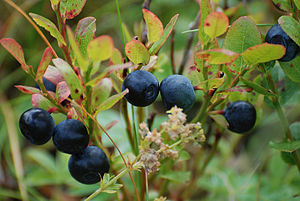July is National Blueberry Month which means it is time to celebrate this little blue ball that is both full of flavor and very good for you. The health benefits of blueberries have been acknowledged since the only people who populated our country were the Native Americans. Packed with vitamins and high in antioxidants, you will be hard pressed to find another food that can tempt your taste buds and take care of your waistline as efficiently as the blueberry. In celebration of this fabulous fruit, here is the low down on the highbush blueberry.
History
The familiar saying “as American as apple pie” could just as easily referred to blueberry pie as these little berries have been growing here for more than 13,000 years. The Native Americans, who called them “star berries” because of the star-like shape of their blossom, used them in a variety of ways. By using preservation techniques like drying and powdering, the Native Americans were able to enjoy the great taste and nutritional benefits of the blueberry all year round. They added them to soups, used them in stew, and made a compound for preserving meat by drying the berries and then grinding them down to powder. If the legends are true, we owe our whole country to the tiny blueberry as they were one of the reasons the first settlers made it through their first long winter.
Blueberries are also an important part of Native American medicinal tradition where all parts of the plant were used to cure and treat illness.
From the time of the first settlers until the turn of the last century, blueberries were only grown in the wild. Most farmers and agricultural specialists did not believe the plant could be domesticated. It wasn’t until 1916 that the first cultivated, commercial crop was grown which opened the door for our year round enjoyment of these delicious and healthy berries today.
Interesting Facts
Blueberries are members of the genus Vaccinium and they belong to the same botanical family as plants like the flowering azalea and mountain laurel. Highbush blueberries, the kind most of us are familiar with, prefer acidic soil and require a lot of water. They generally grow into bushes that are around 6 feet tall, although they can grow as high as 12 feet. When spring comes, the bushes explode with lovely white blossoms, each of which will develop into one blueberry over the course of the summer season. The berries move through several stages as they grow, starting out as hard green balls and ending up as the bright blue balls bursting with flavor and juice.
Unlike other fruit, blueberries that are sold fresh are almost always picked by hand. Machines are used to pick some of the crop, but those berries become the frozen ones available in the freezer case. Once picked, blueberries do best if they are refrigerated.
You can tell the blueberries you are buying are fresh if they are firm, dry, and plump with smooth skin and a silvery surface. Fresh, ripe blueberries will not have leaves or stems attached and will be deep purpley blue to almost bluish black in color.
Start your mornings off right this month with these two great recipes from Fill Your Plate that feature blueberries – Blueberry Muffins and Boss’s Baked French Toast.
Related articles
- What’s in Season for July? (fillyourplate.org)
- Top 6 Summer Picks for Local Arizona Foods (fillyourplate.org)
- 10 Tips for Saving Money on Food (fillyourplate.org)


